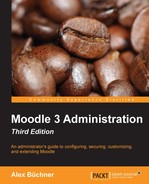Moodle comes with a multitude of configuration options. In this chapter, we will cover the most important settings, most of which are likely to be relevant to your organization. We will distinguish between educational and technical configurations:
- Educational configuration: These settings are likely to require input from other stakeholders in the organization as they cover areas that are of a pedagogical (not technical) nature. The areas that are covered are collaboration (blogs, comments, and tags), badges, LTI, localization, grades and gradebooks, and a number of miscellaneous settings.
- Technical configuration: These are settings that require some technical knowledge about your infrastructure. The topics that are dealt with are synchronous communication (instant messaging and video conferencing), asynchronous communication (inbound and outbound messaging as well as RSS feeds), and a number of experimental settings.
There are a number of additional configuration topics that are covered in dedicated chapters. These topics include plugins (Chapter8, Moodle Plugins), security (Chapter11, Moodle Security and Privacy), optimization (Chapter12, Moodle Performance and Optimization), and networking (Chapter16, Moodle Networking).
One of Moodle's many advantages is its built-in support for collaboration among learners and instructors. This ranges from a number of collaborative course activities, such as, Forum, Wiki, Glossary, and Database, the ability to run activities in a group mode, and support for groupings. Additionally, there are three social activities in Moodle that have to be configured by the administrator. These include blogs, comments, and tags, as discussed in the following sections.
Blogs are a means for users to express themselves either in the form of a learning journal or as a personal account of events. The blogging mechanism provided to users allows the creation of personal as well as public entries and also posts relating to a course.
As an administrator, you will have to Enable blogs in the Advanced features menu. Once the blogs are enabled, there are a number of settings that are available when you navigate to Appearance | Blog:

We have just come across comments in blogs. Moodle comes with a generic comments functionality that is independent of the one in the blogging module. It allows the placement of the Comments block in any context of the system, for instance, in a course or an individual activity.
This feature is enabled by default but can be disabled via the Enable comments parameter in the Advanced features link.
There are a number of areas where additional comment-related settings can be set, for instance, when they are included in backups or supported by certain activities. There is also a report that you can take a look at by going to Reports | Comments, where you can see all the comments that are given throughout the system. You might want to check this every so often in case anything offensive or inappropriate has been entered.
You can search for comments using the Search box to see all of these settings. As always, these settings can be overridden locally via the respective role capabilities.
Tagging is the process of describing artefacts or users using keywords. These tags are then harnessed to search, share, and perform other collaborative activities in order to match interests.
As with blogs and comments, tags can be enabled (this is the default setting) and disabled for the entire site. This can be done via the Enable tags functionality parameter in Advanced features.
Users create their own tags that represent their private or educational interests and, depending on the size of their social network (in our case, Moodle and any Internet services that can be incorporated), matching will take place. However, as an educational institution, you might want to create a number of site-wide tags that can be used in addition to the user-defined tags. Examples of these global tags are organization-related keywords, topics that your entity specializes in, campaigns that your company runs, or newsworthy topics that are relevant to your institution. To set these tags, go to Appearance | Manage tags.

You can add a site-wide tag by entering its name in the textbox at the top and clicking on the Add official tags button. All the global tags are shown in this list, where, for each tag, the following information is displayed:
|
Field |
Description |
|---|---|
|
Tag name |
This is the name of the tag. When you select the tag, you see which users have been tagged with this tag. Furthermore, you have the option to add/remove the tag to suit your own interests and also flag the tag as inappropriate (refer to Flag). |
|
First name/Surname |
This is the creator of the tag, which links to the user profile. |
|
Count |
This is the number of times the tag has been used throughout the site. These will be used as a basis for the Tag block that is shown on the left-hand side. |
|
Flag |
This shows whether the flag has been flagged as inappropriate and the number of times in brackets. |
|
Modified |
This shows the last time the tag was edited. |
|
Official |
When a tag is official, it will show up globally. |
|
Actions |
Editing the tag allows you to add a description and also enter related tags. These will then show up when a user has selected the tag. Deleting will remove the tag from the system. |
If you need to block users from tagging you will need to create a separate role and adjust the two relevant capabilities moodle/tag:create and moodle/tag:edit.
Moodle also supports course tags, allowing students to tag courses. This has to be enabled via the Show course tags parameter in Plugins | Blocks | Tags. Bear in mind that this will change the look of the Tags block.
